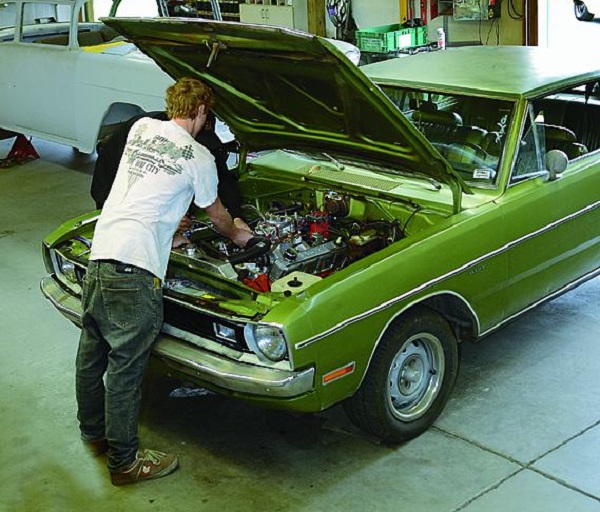Swing n Sting Dart Engine
John and Geoff Stunkard
The fall leaves were changing and the Swing ’N Sting Dart was again back on the road after a year.
Our project, which had received so much assistance from Mancini Racing, Hughes Engines, Hensley Performance, Mr. Gasket, PRW, Cometic, and so many others, was a lot of fun to drive, but we were running into a few issues that we had not planned on. The first was fuel demand; the carb we had selected when using the 318 was really working hard now.
We had made a mistake of not cleaning out the new bowl feed lines, and had gotten a lot of garbage into the internal passages and delicate metering parts of our Quick Fuel Technology’s HR-680-VS model. With 74 more inches thanks to Mancini Racing and Hughes’ super-hot hydraulic Whiplash cam opening the valves in our Magnum-style AAEQ heads, we decided we would check with QFT on our options before going forward with a simple carb rebuild.
Our friend Tracy Hicks of Wizeguy Rod & Custom in Jonesborough, Tennessee, helped us find this car, and had been part of our earlier forays into building it. We called him and he recommended we get into touch with Nickels Performance in Piney Flats, Tennessee. Nickels runs a full-tilt mail-order business that ships worldwide, but they also have a speed shop on the premises. So he called counterman James Edens and got us what we needed in parts to go from the feed line to the regulator and over to the new carb.
New carb? Yep. After checking with QFT, they asked for some info to make a right selection. This information is needed to select the best possible compromise. Our point person there was Bill Wetzel, but you can contact QFT’s other customer service guys to have somebody help you sort out exactly what you need. What Bill and the engineers came up with for us was surprising – the SS-750-AN.
This was because it went against my conventional ideas about both size and vacuum secondary selection. With a 750cfm rating, this is a street carb with mechanical operation, and was selected due in part to the car’s light weight and converter stall. Since we did not have a lot of gear in the back, we would be using the primary section of the carb for street driving; as a square-bore layout, the primary circuit would provide enough fuel for almost 400 cubes under the 3,000 rpm range. However, when that Dynamic-built converter came in hard, all the fuel needed to meet the demand was on tap.
Moreover, the development of annular discharge technology is a terrific benefit over all the things we used to think about carb selection. The annular design places multiple outlets at the lower stepped area of the venturi, creating very precise metering based on actual fuel demand, as well as throttle position. This means more horsepower in most cases and more exact fuel burning due to a better air/fuel mixture as the intake charge enters the intake runner and combustion chamber. With the specs on our Hughes Whiplash cam (which had impressed every single person who has heard it at both idle and at speed), this technology was perfect.
We would be remiss to not add that the SS-750-AN also looks very nice. With red anodized billet metering blocks, booster inserts, and throttle body, plus sight glasses in the float bowls, polished aluminum construction, and the electronic choke, it was a crowning touch to the engine in the car.
But we still needed to install it. That effort was again helped as QFT had a very nice off-the-shelf pressure regulator (p/n 30-803) available as well. For lines and fittings, we went with Engine Works, which is a private label brand that Nickels Performance markets. This included the braided line, plus AN-6 fittings and couplings; everything was on the shelf and, having talked to James ahead of time, the order was ready to be picked up and paid for when we arrived.
The Nickels Speed Shop is very cool, as it is one of the few places still having retail space for performance products; the only similar design with such a large variety we had seen recently had been Mancini’s Clinton Township location, which is the last speed shop still open in the greater Detroit area. At any rate, we were ready to go, and we headed the 30 miles to Jonesborough where Tracy would help us out.
The result? Let’s just say that we might need some tires soon! Tracy, whose 540-inch Rodeck Chevelle is scary fast, came back from the first test run with a big smile and the rubber streaked down onto the country pavement was through most of second gear.
Content provided by amosauto.com

